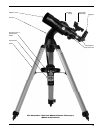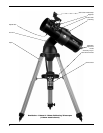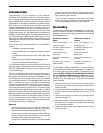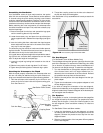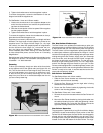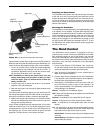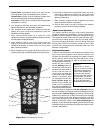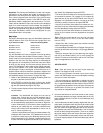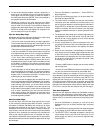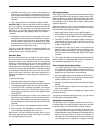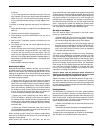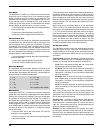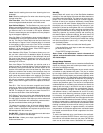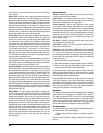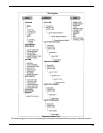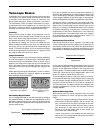
11
6. For the second alignment object, choose a bright star or
planet as far as possible from the first alignment object.
Once again use the arrow button to center the object in
the finderscope and press ENTER. Then once centered in
the eyepiece press the ALIGN button.
7. Repeat the process for the third alignment star. When
the telescope has been aligned to the final stars, the dis-
play will read Match Confirmed. Press UNDO to display the
names of the three bright objects you aligned to, or press
ENTER to accept these three objects for alignment. You
are now ready to find your first object.
Tips for Using Sky Align
Remember the following alignment guidelines to make using
Sky Align as simple and accurate as possible.
• Be sure to level the tripod before you begin alignment.
The time/site information along with a level tripod will help
the telescope better predict the available bright stars and
planets that are above the horizon.
• Remember to select alignment stars that are as far apart
in the sky as possible. For best results make sure that the
third alignment star does not lie in a straight line between
the first two stars. This may result in a failed alignment.
• Don’t worry about confusing planets for stars when
selecting alignment objects. SkyAlign works with the four
brightest planets (Venus, Jupiter, Saturn and Mars) as well
as the Moon. In addition to the planets, the hand control
has over 80 bright alignment stars to choose from (down
to 2.5 magnitude).
• Rarely SkyAlign will not be able to determine what three
alignment objects were centered. This sometime happens
when a bright planet or the Moon passes near one of the
brighter stars. In situations like these it is best to try to
avoid aligning to either object if possible.
• Be sure to center the objects with the same final move-
ments as the direction of the GoTo Approach. For example,
if the scope normally finishes a GoTo with the front of the
scope moving right and up, you should center all three
alignment objects in the eyepiece using the right and up
arrow buttons (the up/down arrows reverse at slew rates
of 6 or lower). Approaching the star from this direction
when looking through the eyepiece will eliminate much
of the backlash between the gears and assure the most
accurate alignment possible.
Auto Two-Star Align
As with Sky Align, Auto Two-Star Align requires you to enter
all the necessary time/site information as before. Once this
information is entered, StarSeeker will prompt you to select
and point the telescope at one known star in the sky. The
StarSeeker now has all the information it needs to automati-
cally choose a second star that will assure the best possible
alignment. Once selected, the telescope will automatically
slew to that second alignment star to complete the align-
ment. With the StarSeeker set up outside with all accessories
attached and the tripod leveled, follow the steps below to align
the telescope:
1. Once the StarSeeker is powered on , Press ENTER to
begin alignment.
2. Use the Up and Down scroll keys (10) to select Auto Two-
Star Align and press ENTER.
3. The hand control will display the last time and location
information that was entered into the hand control. Use
the Up and Down buttons to scroll through the information.
Press ENTER to accept the current information or press
UNDO to manually edit the information (see Sky Align
section for detailed instruction on entering time/site infor-
mation).
4. The display will now prompt you to select a bright star from
the displayed list on the hand control. Use Up and Down
buttons (6 and 9 on the keypad) to scroll to the desired
star and then press ENTER.
5. Use the arrow buttons to slew the telescope to the star
you selected. Center the star in the finderscope and press
ENTER. Finally, center the star in the eyepiece and press
ALIGN.
6. Based on this information, the StarSeeker will automati-
cally display the most suitable second alignment star that
is above the horizon. Press ENTER to automatically slew
the telescope to the displayed star. If for some reason you
do not wish to select this star (perhaps it is behind a tree
or building), you can either:
• Press the UNDO button to display the next most suitable
star for alignment.
• Use the UP and DOWN scroll buttons to manually select
any star you wish from the entire list of available stars.
Once finished slewing, the display will ask you to use the
arrow buttons to align the selected star with the red dot of the
finderscope. Once centered in the finder, press ENTER. The
display will then instruct you to center the star in the field of
view of the eyepiece. When the star is centered, press ALIGN
to accept this star as your second alignment star. When the
telescope has been aligned to both stars the display will read
Align Success, and you are now ready to find your first object.
Two Star Alignment
With the two-star alignment method, the StarSeeker requires
the user to know the positions of two bright stars in order to
accurately align the telescope with the sky and begin finding
objects. Here is an overview of the two-star alignment proce-
dure:
1. Once the StarSeeker is powered on, use the Up and
Down scroll keys (10) to select Two-Star Align, and press
ENTER.
2. Press ENTER to accept the time/site information displayed
on the display, or press UNDO to enter new information.
3. The SELECT STAR 1 message will appear in the top row
of the display. Use the Up and Down scroll keys (10) to
select the star you wish to use for the first alignment star.
Press ENTER.



